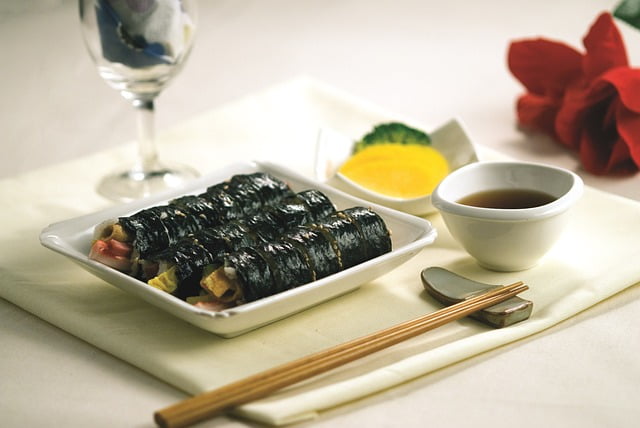Delicious Homemade Gimbap (Kimbap) Recipe
Table of Contents
Introduction:
Gimbap, a popular Korean dish, is a delightful combination of fresh ingredients and flavors wrapped in a sheet of seaweed. It’s a fantastic option for a quick snack, lunch, or even a party appetizer. In this recipe, I’ll guide you through the steps to create your own mouthwatering gimbap right in your kitchen.
Ingredients:
For the Rice:
- 2 cups sushi rice, washed and drained
- 2 1/2 cups water
- 3 tablespoons rice vinegar
- 2 tablespoons sugar
- 1 teaspoon salt
For the Fillings (customize as you like):
- 8-10 sheets of roasted seaweed (nori)
- 1 carrot, julienned
- 1 cucumber, julienned
- 1 yellow bell pepper, julienned
- 1 avocado, sliced
- 8-10 sticks of imitation crab meat or cooked shrimp
- 4-5 eggs, beaten and cooked into thin omelets, then julienned
- Sesame oil for brushing
For Assembly:
- Soy sauce and wasabi for dipping
Instructions:
- Prepare the Rice:
- In a medium-sized pot, combine the washed sushi rice and water. Let it soak for about 30 minutes.
- Bring the rice to a boil over medium-high heat. Once boiling, reduce the heat to low, cover, and let it simmer for 15-20 minutes, or until the rice is cooked and the water is absorbed.
- In a small bowl, mix together the rice vinegar, sugar, and salt until dissolved. Once the rice is cooked, transfer it to a large mixing bowl and gently fold in the vinegar mixture. Allow the rice to cool to room temperature.
- Prepare the Fillings:
- Julienne the carrot, cucumber, yellow bell pepper, and cooked omelets.
- Slice the avocado and prepare the imitation crab meat or shrimp.
- Assembly:
- Place a bamboo sushi rolling mat on a clean surface and cover it with plastic wrap. Lay a sheet of roasted seaweed (nori) on the mat with the shiny side down.
- Wet your hands slightly to prevent the rice from sticking. Spread a thin, even layer of rice over the seaweed, leaving about 1 inch at the top edge.
- Arrange the fillings horizontally across the center of the rice. Be creative with your combinations!
- Rolling the Gimbap:
- Lift the edge of the bamboo mat closest to you and start rolling the gimbap away from you, tucking in the fillings tightly. Use the mat to help shape the roll.
- Once rolled, brush the top edge of the seaweed with a little sesame oil to seal the gimbap.
- Slicing and Serving:
- Use a sharp knife to slice the gimbap into bite-sized pieces.
- Arrange the sliced gimbap on a serving platter and serve with soy sauce and wasabi for dipping.
- Enjoy:
- Your homemade gimbap is ready to be enjoyed! The combination of flavors and textures in each bite is sure to tantalize your taste buds.
Conclusion:
Making your own gimbap at home is a rewarding culinary experience. Feel free to get creative with your fillings, and don’t be afraid to experiment with different combinations. Whether you’re enjoying it as a snack or serving it at a gathering, gimbap is a crowd-pleaser that brings a taste of Korea to your table.

